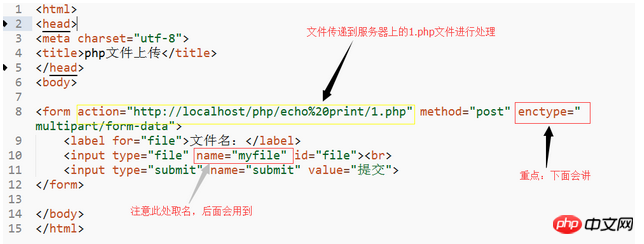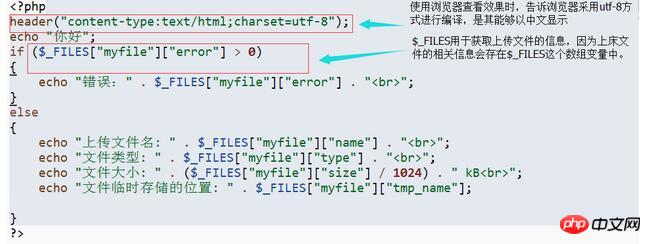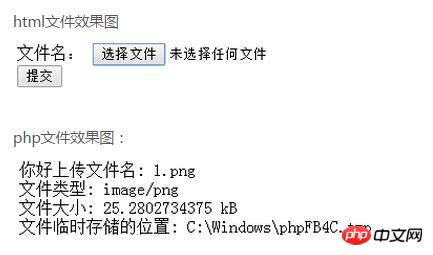Detailed explanation of file upload in php
Have you really mastered php file upload technology? This article has compiled relevant information on PHP file uploading for everyone. It has certain reference value. Interested friends can refer to it.
First of all, let me state that this chapter has a lot of content and is relatively difficult. , you have to have an attitude of fighting with yourself. Don’t miss the subtleties, practice more and more is the way to go.
Learning is like climbing a mountain. You have to do it step by step. First, set a small goal for yourself, and then continue to climb higher and higher, and finally reach the top.
Please consider the above two pieces of advice carefully
1. Description of my preparations.
Editor: sublime text3 (Which editor you use depends on your preference)
Server build: Use phpstudy2014 to build the server. The server file is stored in the www file on the D drive of my computer. (Installing phpstudy will automatically generate the www file, you decide which disk to install it on). Run phpstudy and enter localhost in the browser address bar to access files on the server.
The process of uploading files: The browser uploads the file on the client, click submit, the file is sent to a php file in the server for processing, and the php uploads the file Save the file to the server.
2. Create the form
Please see my html code

1. application/x-www-form-urlencoded: Form data is encoded as name/value pairs. This is a standard encoding format.
2. multipart/form-data: Form data is encoded as a message, and each control on the page corresponds to a part of the message.
3. text/plain: The form data is encoded in plain text, without any controls or formatting characters.
Supplement (just take a look): The enctype attribute of ORM is the encoding method. There are two commonly used ones: application/x-www-form-urlencoded and multipart/form-data. The default is application/x-www-form. -urlencoded. When the action is get, the browser uses the x-www-form-urlencoded encoding method to convert the form data into a string (name1=value1&name2=value2...), and then appends the string to the end of the url, splits it with ?, and loads it. this new url. When the action is post, the browser encapsulates the form data into the http body and then sends it to the server. If there is no type=file control, just use the default application/x-www-form-urlencoded. But if there is type=file, multipart/form-data will be used. The browser will divide the entire form into control units, and add Content-Disposition (form-data or file), Content-Type (default is text/plain), name (control name) and other information to each part, and Add delimiter (boundary).
In short, remember two sentences: if there is type=file in the input tag, then enctype=multipart/form-data. If there is no type=file, application/x-www-form-urlencoded is generally used.
When uploading files, the data must undergo certain transformations before they can be uploaded to the server. The difference between application/x-www-form-urlencoded and multipart/form-data is the conversion encoding method.
3. Create a php file to process the uploaded files.


FILES["myfile"]["error"]=1 The uploaded file exceeds the server limit, such as exceeding the server space size. _FILES["myfile"]["error"]=2 exceeds the browser limit for uploading $_FILES["myfile"]["error"]=3 Only part of the file is uploaded
Upload limit
Normally, the server usually limits the size or type of files uploaded by the server. We add restrictions on the uploaded file code based on the above php code.
First familiarize yourself with the usage of several functions:
explode()The function is used to split strings. For example: explode(“.”,”aaa.HTML”) is to divide this at the position of the dot. The string is divided into two strings, "aaa" and "HTML", and these two strings are stored in the same array in order.
end()Get the value of the last element in the array.
in_array() Search for an element in the array to see if it exists. It returns true if it exists and false if it does not exist.
<?php
//第一步:明确服务器规定上传至服务器的文件类型。这里我们只允许上传以下类型的图片。
$allowedExts = array("gif", "jpeg", "jpg", "png");// 允许上传的图片后缀
//第二部:获取上传的文件名称,通过explorde()函数将其分割成字符串形式的数组。
$temp = explode(".", $_FILES["myfile"]["name"]);
echo $_FILES["file"]["size"];
$extension = end($temp); // end函数用于获取数组中最后一个元素的值。
//第三步:列出上传文件需要满足的条件
if ((($_FILES["myfile"]["type"] == "image/gif")
|| ($_FILES["myfile"]["type"] == "image/jpeg")
|| ($_FILES[myfile"]["type"] == "image/jpg")
|| ($_FILES["myfile"]["type"] == "image/pjpeg")
|| ($_FILES["myfile"]["type"] == "image/x-png")
|| ($_FILES["myfile"]["type"] == "image/png"))
&& ($_FILES["myfile"]["size"] < 204800) // 小于 200 kb
&& in_array($extension, $allowedExts))
//in_array表示在$allowedExts数组中查找$extension这个字符串
{
if ($_FILES["myfile"]["error"] > 0)
{
echo "错误:: " . $_FILES["myfile"]["error"] . "<br>";
//举个例子服务器空间不足,文件只能上传部分就会出现错误。
}
else
{
echo "上传文件名: " . $_FILES["myfile"]["name"] . "<br>";
echo "文件类型: " . $_FILES["myfile"]["type"] . "<br>";
echo "文件大小: " . ($_FILES["myfile"]["size"] / 1024) . " kB<br>";
echo "文件临时存储的位置: " . $_FILES["myfile"]["tmp_name"] . "<br>";
}
}
else
{
echo "非法的文件格式";
}
?>4. Save the uploaded file
After the file is uploaded, it is saved in a temporary location. It will disappear when the script ends. If we want to save it permanently on the server, we need to save it in another location.
. file_exists("upload/" . FILES["file"]["name"]) checks whether the file or directory exists. .moveuploadedfile(_FILES["file"]["tmp_name"], "upload/" . $_FILES["myfile"]["name"]);Move the uploaded file from the temporary location to the server space.
<?php
//第一步:明确服务器规定上传至服务器的文件类型。这里我们只允许上传以下类型的图片。
$allowedExts = array("gif", "jpeg", "jpg", "png");// 允许上传的图片后缀
//第二部:获取上传的文件名称,通过explorde()函数将其分割成字符串形式的数组。
$temp = explode(".", $_FILES["myfile"]["name"]);
echo $_FILES["myfilefile"]["size"];
$extension = end($temp); // end函数用于获取数组中最后一个元素的值。
//第三步:列出上传文件需要满足的
if ((($_FILES["myfile"]["type"] == "image/gif")
|| ($_FILES["myfile"]["type"] == "image/jpeg")
|| ($_FILES["myfile"]["type"] == "image/jpg")
|| ($_FILES["myfile"]["type"] == "image/pjpeg")
|| ($_FILES["myfile"]["type"] == "image/x-png")
|| ($_FILES["myfile"]["type"] == "image/png"))
&& ($_FILES["myfile"]["size"] < 204800) // 小于 200 kb
&& in_array($extension, $allowedExts))//in_array表示在$allowedExts数组中查找$extension这个字符串
{
if ($_FILES["myfilefile"]["error"] > 0)
{
echo "错误:: " . $_FILES["myfile"]["error"] . "<br>";
}
else
{
echo "上传文件名: " . $_FILES["myfile"]["name"] . "<br>";
echo "文件类型: " . $_FILES["myfile"]["type"] . "<br>";
echo "文件大小: " . ($_FILES["myfile"]["size"] / 1024) . " kB<br>";
echo "文件临时存储的位置: " . $_FILES["myfile"]["tmp_name"] . "<br>";
// 判断当期目录(即www文件夹中)下的 upload 目录(自己创建,名字自取)是否存在该文件
// 如果没有 upload 目录,你需要创建它,upload 目录权限为 777
if (file_exists("upload/" . $_FILES["myfile"]["name"]))
{
echo $_FILES["myfile"]["name"] . " 文件已经存在。 ";
}
else
{
// 如果 upload 目录不存在该文件则将文件上传到 upload 目录下
move_uploaded_file($_FILES["myfile"]["tmp_name"], "upload/" . $_FILES["file"]["name"]);//
echo "文件存储在: " . "upload/" . $_FILES["myfile"]["name"];
}
}
}
else
{
echo "非法的文件格式";
}
?>The above is the entire content of this article, I hope it will be helpful to everyone's study.
Related recommendations:
How to combine two photos of the front and back of an ID card into one picture using PHP
PHP uses SWOOLE extension to implement scheduled synchronization of MySQL data
##PHP summary of object knowledge
The above is the detailed content of Detailed explanation of file upload in php. For more information, please follow other related articles on the PHP Chinese website!

Hot AI Tools

Undresser.AI Undress
AI-powered app for creating realistic nude photos

AI Clothes Remover
Online AI tool for removing clothes from photos.

Undress AI Tool
Undress images for free

Clothoff.io
AI clothes remover

Video Face Swap
Swap faces in any video effortlessly with our completely free AI face swap tool!

Hot Article

Hot Tools

Notepad++7.3.1
Easy-to-use and free code editor

SublimeText3 Chinese version
Chinese version, very easy to use

Zend Studio 13.0.1
Powerful PHP integrated development environment

Dreamweaver CS6
Visual web development tools

SublimeText3 Mac version
God-level code editing software (SublimeText3)

Hot Topics
 1668
1668
 14
14
 1427
1427
 52
52
 1329
1329
 25
25
 1273
1273
 29
29
 1256
1256
 24
24
 PHP: A Key Language for Web Development
Apr 13, 2025 am 12:08 AM
PHP: A Key Language for Web Development
Apr 13, 2025 am 12:08 AM
PHP is a scripting language widely used on the server side, especially suitable for web development. 1.PHP can embed HTML, process HTTP requests and responses, and supports a variety of databases. 2.PHP is used to generate dynamic web content, process form data, access databases, etc., with strong community support and open source resources. 3. PHP is an interpreted language, and the execution process includes lexical analysis, grammatical analysis, compilation and execution. 4.PHP can be combined with MySQL for advanced applications such as user registration systems. 5. When debugging PHP, you can use functions such as error_reporting() and var_dump(). 6. Optimize PHP code to use caching mechanisms, optimize database queries and use built-in functions. 7
 PHP and Python: Comparing Two Popular Programming Languages
Apr 14, 2025 am 12:13 AM
PHP and Python: Comparing Two Popular Programming Languages
Apr 14, 2025 am 12:13 AM
PHP and Python each have their own advantages, and choose according to project requirements. 1.PHP is suitable for web development, especially for rapid development and maintenance of websites. 2. Python is suitable for data science, machine learning and artificial intelligence, with concise syntax and suitable for beginners.
 PHP vs. Python: Understanding the Differences
Apr 11, 2025 am 12:15 AM
PHP vs. Python: Understanding the Differences
Apr 11, 2025 am 12:15 AM
PHP and Python each have their own advantages, and the choice should be based on project requirements. 1.PHP is suitable for web development, with simple syntax and high execution efficiency. 2. Python is suitable for data science and machine learning, with concise syntax and rich libraries.
 PHP in Action: Real-World Examples and Applications
Apr 14, 2025 am 12:19 AM
PHP in Action: Real-World Examples and Applications
Apr 14, 2025 am 12:19 AM
PHP is widely used in e-commerce, content management systems and API development. 1) E-commerce: used for shopping cart function and payment processing. 2) Content management system: used for dynamic content generation and user management. 3) API development: used for RESTful API development and API security. Through performance optimization and best practices, the efficiency and maintainability of PHP applications are improved.
 The Enduring Relevance of PHP: Is It Still Alive?
Apr 14, 2025 am 12:12 AM
The Enduring Relevance of PHP: Is It Still Alive?
Apr 14, 2025 am 12:12 AM
PHP is still dynamic and still occupies an important position in the field of modern programming. 1) PHP's simplicity and powerful community support make it widely used in web development; 2) Its flexibility and stability make it outstanding in handling web forms, database operations and file processing; 3) PHP is constantly evolving and optimizing, suitable for beginners and experienced developers.
 PHP vs. Other Languages: A Comparison
Apr 13, 2025 am 12:19 AM
PHP vs. Other Languages: A Comparison
Apr 13, 2025 am 12:19 AM
PHP is suitable for web development, especially in rapid development and processing dynamic content, but is not good at data science and enterprise-level applications. Compared with Python, PHP has more advantages in web development, but is not as good as Python in the field of data science; compared with Java, PHP performs worse in enterprise-level applications, but is more flexible in web development; compared with JavaScript, PHP is more concise in back-end development, but is not as good as JavaScript in front-end development.
 PHP and Python: Different Paradigms Explained
Apr 18, 2025 am 12:26 AM
PHP and Python: Different Paradigms Explained
Apr 18, 2025 am 12:26 AM
PHP is mainly procedural programming, but also supports object-oriented programming (OOP); Python supports a variety of paradigms, including OOP, functional and procedural programming. PHP is suitable for web development, and Python is suitable for a variety of applications such as data analysis and machine learning.
 PHP and Python: Code Examples and Comparison
Apr 15, 2025 am 12:07 AM
PHP and Python: Code Examples and Comparison
Apr 15, 2025 am 12:07 AM
PHP and Python have their own advantages and disadvantages, and the choice depends on project needs and personal preferences. 1.PHP is suitable for rapid development and maintenance of large-scale web applications. 2. Python dominates the field of data science and machine learning.




